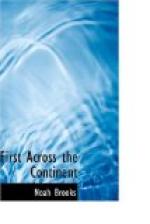The party found quantities of wild onions of good flavor and size. They also observed wild flax, garlic, and other vegetable products of value. The journal adds:—
“We saw many otter and beaver to-day (July 24th). The latter seem to contribute very much to the number of islands, and the widening of the river. They begin by damming up the small channels of about twenty yards between the islands: this obliges the river to seek another outlet, and, as soon as this is effected, the channel stopped by the beaver becomes filled with mud and sand. The industrious animal is then driven to another channel, which soon shares the same fate, till the river spreads on all sides, and cuts the projecting points of the land into islands. We killed a deer, and saw great numbers of antelopes, cranes, some geese, and a few red-headed ducks. The small birds of the plains and the curlew are still abundant: we saw a large bear, but could not come within gunshot of him. There are numerous tracks of the elk, but none of the animals themselves; and, from the appearance of bones and old excrement, we suppose that buffalo sometimes stray into the valley, though we have as yet seen no recent sign of them. Along the water are a number of snakes, some of a uniform brown color, others black, and a third speckled on the abdomen, and striped with black and a brownish yellow on the back and sides. The first, which is the largest, is about four feet long; the second is of the kind mentioned yesterday; and the third resembles in size and appearance the garter-snake of the United States. On examining the teeth of all these several kinds, we found them free from poison: they are fond of the water, in which they take shelter on being pursued. The mosquitoes, gnats, and prickly pear, our three persecutors, still continue with us, and, joined with the labor of working the canoes, have fatigued us all excessively.”
On Thursday, July 25, Captain Clark, who was in the lead, as usual, arrived at the famous Three Forks of the Missouri. The stream flowing in a generally northeastern direction was the true, or principal Missouri, and was named the Jefferson. The middle branch was named the Madison, in honor of James Madison, then Secretary of State, and the fork next to the eastward received the name of Albert Gallatin, then Secretary of the Treasury; and by these titles the streams are known to this day. The explorers had now passed down to their furthest southern limit, their trail being to the eastward of the modern cities of Helena and Butte, and separated only by a narrow divide (then unknown to them) from the sources of some of the streams that fall into the Pacific Ocean. Under the date of July 27, the journal says:—




